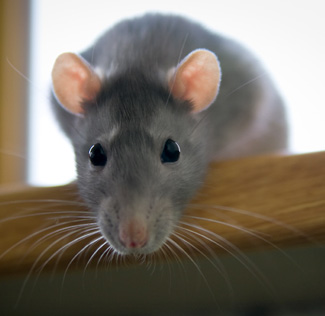
While they are small in size, rats and mice are unfortunately quite mighty when it comes to the damage that they can wreak on the health and well-being of humans, pets and property. Some dangers that rats pose include gnawing through wiring in buildings and cars, insulation, roofing material and even water pipes. In addition to the negative consequences of their chewing and gnawing, rodent damage also comes from the nests that they build, their trails of waste and their contamination of the food in your pantry. These three other forms of destruction are also often the sources of diseases spread by mice and rats.
Mice and rats are a serious safety concern, so contact your local pest and animal control expert instead of wasting time trying to tell the difference between them. It is probably wishful thinking that there is only one mouse in your house, so take action immediately if you see one or suspect their presence by calling in the extermination specialists, like the team at Eliminate ‘Em. Your quick connection with a mice and rat extermination team is the best way to avoid compromising the safety of your home and exposing yourself or those you care about to any of these 8 diseases associated with rodents.
Hantavirus
This disease is transmitted through the saliva, urine and feces of mice and rodents, as well as any food or nesting material exposed to those bodily products. At its most severe, infection with this virus can lead to severe respiratory illness.
Lymphocytic Choriomeningitis (LCM)
House mice are frequent carriers of this serious disease. The Lymphocytic Choriomeningitis Virus transmits from its host to other living beings through their contact with assorted bodily excretions and inhalation of air exposed to these substances. While children and adults tend to experience symptoms like fever, fatigue, headaches and nausea, more severe cases can present with neurological problems. Additionally, unborn fetuses may experience more significant birth defects if infected.
Tularemia
As explained by the American Veterinary Medicine Association, tularemia is caused by bacteria and more typically associated with rabbits, but mice can also carry the Francisella tularensis bacteria. In terms of pet safety, cats are more susceptible to the disease than dogs, but dogs may be carriers. Birds, fish and reptile pets are rarely infected. If exposed, humans and pets tend to come into contact with this disease because of bites from rats or mice or exposure to contaminated food, water or air. Fever, skin ulcers and vomiting are common indicators of this illness in humans and pets, and both sepsis and death may occur. Since ticks can also be a carrier, tick extermination can be a helpful preventative measure.
Leptospirosis
Both rats and mice carry the bacteria that causes Leptospirosis. When their urine comes into contact with soil or water, humans and pets can be exposed through wounds, as well as nose or mouth consumption. Initial symptoms tend to mirror those of the flu (fever, headache, diarrhea), but another stage of the infection can lead to an illness called Weil’s syndrome and associated complications such as internal bleeding or kidney damage.
Plague
People across the world and throughout time have been impacted by the plague. Mice and rats are carriers but transmission of this disease to other human and animal hosts typically happens via fleas. Much like many of the other diseases on this list, people with the plague experience flu-like symptoms. With quick diagnosis, antibiotics can effectively treat this illness, but delayed identification can prove fatal.
Rat Bite Fever
As its name suggests, rat-bite fever is typically caused by a bite or scratch from an infected animal or contact with its fluid, such as through contaminated food products or surfaces. Different types of bacteria can cause this rat-transmitted disease, so symptoms vary accordingly but fever, chills and rashes are common. Early detection and treatment with antibiotics can remedy this illness, but heart and brain problems are potentially extreme complications.
Salmonella
Another bacterial complication resulting from the consumption of water or food contaminated by fecal matter from a rodent carrier, salmonella often leads to diarrhea or other stomach pain, as well as fever, in most cases. Most healthy individuals recover fairly quickly.
EOSINOPHILIC MENINGITIS
The parasites that can cause eosinophilic meningitis normally infect animals, but eating food contaminated by sick pests can make humans sick too. Those infected may experience stiffness, light sensitivity, confusion, tingling or painful skin or eye issues, as well as the paralysis, coma and death in severe cases.
While some of these diseases may be relatively rare, the best defenses against even the smallest possibility that the rats and mice in your home or surrounding area could be carrying disease are prevention and quick and efficient elimination. For 24/7 pest control service or preventative maintenance, then contact us today.


